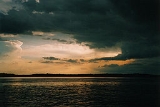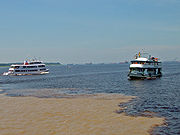
Rio Negro
Encyclopedia
Rio Negro is the largest left tributary of the Amazon
and the largest blackwater river
in the world. It has its sources along the watershed between the Orinoco
and the Amazon basins, and also connects with the Orinoco by way of the Casiquiare canal
in southern Venezuela
. In Colombia, where the Rio Negro's sources are located, it is called the Guainía River. Its main affluent is the Vaupés
, which disputes with the headwaters of the Guaviare
branch of the Orinoco
, the drainage of the eastern slope of the Andes
of Colombia
. The Rio Negro flows into the Rio Solimões to form the Amazon River South of Manaus
, Brazil
.
Rio Negro is navigable for 700 kilometres (435 mi) from its mouth in 1 metre of water in the dry season, but it has many sandbanks and minor difficulties. A small portion of it forms the international boundary between Colombia and Venezuela.
In the wet season
, it floods the country far and wide, sometimes to a width of 30 kilometres (18.6 mi), for long distances, and for 650 kilometres (403.9 mi) upstream. During this time, from April until October, it is a succession of lagoons, full of long islands and intricate channels as far as Santa Isabel do Rio Negro
. The foothills of the Andes begin just before reaching the Vaupés River
. At this point, the Negro narrows and is filled with many large rocks over which it violently flows in cataracts, rapids and whirlpools. Despite the impediments, canoes and motor launches ascend past São Gabriel da Cachoeira
to the Andes
.
 While the name Rio Negro means Black River, its waters aren't exactly black; they are similar in color to strong tea
While the name Rio Negro means Black River, its waters aren't exactly black; they are similar in color to strong tea
. The dark color comes from humic acid
from incomplete breakdown of phenol-containing vegetation from sandy clearings. The river's name arises from the fact that it looks black from afar.
Much has been written on the productivity of the Rio Negro and other blackwater rivers. The older idea that these are "hunger rivers" is giving way, with new research, to the recognition that the Rio Negro, for example, supports a large fishing industry and has numerous turtle beaches. If the Negro was empty of Indians during the 17th century, introduced exotic diseases and warfare are more likely causes than low river productivity.
Amazon River
The Amazon of South America is the second longest river in the world and by far the largest by waterflow with an average discharge greater than the next seven largest rivers combined...
and the largest blackwater river
Blackwater river
A blackwater river is a river with a deep, slow-moving channel that flows through forested swamps and wetlands. As vegetation decays in the water, tannins are leached out, resulting in transparent, acidic water that is darkly stained, resembling tea or coffee. Most major blackwater rivers are in...
in the world. It has its sources along the watershed between the Orinoco
Orinoco
The Orinoco is one of the longest rivers in South America at . Its drainage basin, sometimes called the Orinoquia, covers , with 76.3% of it in Venezuela and the remainder in Colombia...
and the Amazon basins, and also connects with the Orinoco by way of the Casiquiare canal
Casiquiare canal
The Casiquiare river is a distributary of the upper Orinoco flowing southward into the Rio Negro, in Venezuela, South America. As such, it forms a unique natural canal between the Orinoco and Amazon river systems. It is the largest river on the planet that links two major river systems, a...
in southern Venezuela
Venezuela
Venezuela , officially called the Bolivarian Republic of Venezuela , is a tropical country on the northern coast of South America. It borders Colombia to the west, Guyana to the east, and Brazil to the south...
. In Colombia, where the Rio Negro's sources are located, it is called the Guainía River. Its main affluent is the Vaupés
Vaupés River
Vaupés River is a tributary of the Rio Negro in South America. It arises in the Guaviare Department of Colombia, flowing east through Guaviare and Vaupés Departments. It forms part of the international border between Colombia and the Amazonas state of Brazil. On the border it merges with the...
, which disputes with the headwaters of the Guaviare
Guaviare River
The Guaviare is a tributary of the Orinoco located in Colombia.The Guaviare has its source in two other rivers, the Ariari and the Guayabero, which in turn have their own sources in the eastern part of the Andes. At long, it is the longest river on the Orinoco and is navigable for of its total...
branch of the Orinoco
Orinoco
The Orinoco is one of the longest rivers in South America at . Its drainage basin, sometimes called the Orinoquia, covers , with 76.3% of it in Venezuela and the remainder in Colombia...
, the drainage of the eastern slope of the Andes
Andes
The Andes is the world's longest continental mountain range. It is a continual range of highlands along the western coast of South America. This range is about long, about to wide , and of an average height of about .Along its length, the Andes is split into several ranges, which are separated...
of Colombia
Colombia
Colombia, officially the Republic of Colombia , is a unitary constitutional republic comprising thirty-two departments. The country is located in northwestern South America, bordered to the east by Venezuela and Brazil; to the south by Ecuador and Peru; to the north by the Caribbean Sea; to the...
. The Rio Negro flows into the Rio Solimões to form the Amazon River South of Manaus
Manaus
Manaus is a city in Brazil, the capital of the state of Amazonas. It is situated at the confluence of the Negro and Solimões rivers. It is the most populous city of Amazonas, according to the statistics of Brazilian Institute of Geography and Statistics, and is a popular ecotourist destination....
, Brazil
Brazil
Brazil , officially the Federative Republic of Brazil , is the largest country in South America. It is the world's fifth largest country, both by geographical area and by population with over 192 million people...
.
Rio Negro is navigable for 700 kilometres (435 mi) from its mouth in 1 metre of water in the dry season, but it has many sandbanks and minor difficulties. A small portion of it forms the international boundary between Colombia and Venezuela.
In the wet season
Wet season
The the wet season, or rainy season, is the time of year, covering one or more months, when most of the average annual rainfall in a region occurs. The term green season is also sometimes used as a euphemism by tourist authorities. Areas with wet seasons are dispersed across portions of the...
, it floods the country far and wide, sometimes to a width of 30 kilometres (18.6 mi), for long distances, and for 650 kilometres (403.9 mi) upstream. During this time, from April until October, it is a succession of lagoons, full of long islands and intricate channels as far as Santa Isabel do Rio Negro
Santa Isabel do Rio Negro
Santa Isabel do Rio Negro is a municipality located in the Brazilian state of Amazonas. Its population was 7,617 and its area is . The Municipality was formerly called Tapuruquara....
. The foothills of the Andes begin just before reaching the Vaupés River
Vaupés River
Vaupés River is a tributary of the Rio Negro in South America. It arises in the Guaviare Department of Colombia, flowing east through Guaviare and Vaupés Departments. It forms part of the international border between Colombia and the Amazonas state of Brazil. On the border it merges with the...
. At this point, the Negro narrows and is filled with many large rocks over which it violently flows in cataracts, rapids and whirlpools. Despite the impediments, canoes and motor launches ascend past São Gabriel da Cachoeira
São Gabriel da Cachoeira
São Gabriel da Cachoeira is a city and a Municipality located on the Northern shores of the Rio Negro River, in the region of Cabeça do Cachorro, Amazonas state, Brazil. Between 1952 and 1966, it was officially called Uaupés, after the nearby Vaupés River. Most of its inhabitants are indigenous...
to the Andes
Andes
The Andes is the world's longest continental mountain range. It is a continual range of highlands along the western coast of South America. This range is about long, about to wide , and of an average height of about .Along its length, the Andes is split into several ranges, which are separated...
.

Tea
Tea is an aromatic beverage prepared by adding cured leaves of the Camellia sinensis plant to hot water. The term also refers to the plant itself. After water, tea is the most widely consumed beverage in the world...
. The dark color comes from humic acid
Humic acid
Humic acid is a principal component of humic substances, which are the major organic constituents of soil , peat, coal, many upland streams, dystrophic lakes, and ocean water. It is produced by biodegradation of dead organic matter...
from incomplete breakdown of phenol-containing vegetation from sandy clearings. The river's name arises from the fact that it looks black from afar.
Much has been written on the productivity of the Rio Negro and other blackwater rivers. The older idea that these are "hunger rivers" is giving way, with new research, to the recognition that the Rio Negro, for example, supports a large fishing industry and has numerous turtle beaches. If the Negro was empty of Indians during the 17th century, introduced exotic diseases and warfare are more likely causes than low river productivity.

